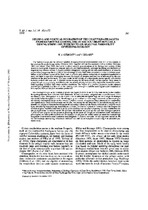Feeding and vertical migration of the chaetognath Sagitta friderici (Ritter Zahony, 1911) in the southern Benguela during spring 1987, with notes on seasonal variability of feeding ecology
Abstract
The feeding biology and the vertical migration of Sagitta friderici were examined over 24 h at two stations in the southern Benguela during spring (October) 1987. Together with studies conducted during summer (February 1991) and winter (May 1984), they serve to allow valuable generalizations of the biology and ecology of this abundant chaetognath. Populations migrate vertically and feed nocturnally, although the timing and the extent of migration vary between studies. S.friderici exhibits ontogenetic layering and the cross-shelf distribution of maturity stages differs, suggesting that it is able to take advantage of cross-shelf water movement in order to maintain populations in the nearshore waters of the West Coast. S.friderici prey almost exclusively on copepodg (cannibalism is rare), and there is a positive relationship between the lengths of predator and prey that is influenced by the size structure of the prey environment. This casts doubt on the validity of a chaetognath species-specific relationship between predator and prey size. S. friderici selects its prey on the basis of size, and not species. Daily ration is related linearly to prey density, so reflecting the low density of prey and providing support for theoretical predictions regarding ingestion rates under oceanic conditions. The impact of S. friderici predation on the copepod assemblage is generally less than 3% of the standing stock, although it could be much higher under conditions of low copepod biomass and poor secondary production.

